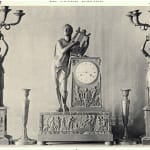
Elke Niehüser, "French Bronze Clocks," 1700 - 1830, p. 30 - 31.
Claude Galle
Further images
A very fine Empire gilt and patinated bronze and verde antico marble figural clock by Claude Galle,
signed on the white enamel dial Galle, Rue Vivienne No. 9
Paris, date cira 1805
Height 61 cm.
Galle was born at Villepreux near Versailles; during his youth he moved to Paris to begin an apprenticeship under the fondeur, Pierre Foy at rue du Four. In 1784 Galle married Foy's daughter, Marie-Elizabeth, when Foy died in 1788 Galle was required to pay off the elder's debts before taking over the workshop, which he built up into one the finest of its kind, eventually employing about 400 craftsmen. Galle moved the business to Quai de la Monnaie (renamed Quai de 1'Unité) and from 1805 operated from 60 Rue Vivienne, close to fellow fondeur, Pierre-Victor Ledure. From 1784 Galle began appearing in the trade registers; he became a maitre-fondeur in 1786 and in the same year received the first of many commissions from the Garde-Meuble to furnish the royal palaces, which in addition to Fontainebleau included the Châteaux de Saint-Cloud, Compiègne and Rambouillet, Le Palais des Tuileries, Les Trianons, as well as Monte Cavallo Rome and Stupinigi near Turin. Today Galle's work can be found amongst the world's finest collections, which in addition to the above include the Musée National de Chateau de Malmaison, the Musée Marmottan in Paris, the Museo de Reloges at Jerez de la Frontera, the Residenz Munich and the Victoria and Albert Museum in London.




